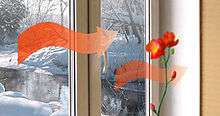Heatable glass

Electrically heatable glass and windows are relatively new products, which help solve problems in the design of buildings and vehicles. The idea of heating glass is based on the use of energy-efficient low-emissive glass, which is generally simple silicate glass with a special metallic oxides coating. Low-emissive coating decreases heat loss by approximately 30%. Heatable glass can be used in all kinds of standard glazing systems, whether wood, plastic, aluminum or steel.
Heatable glass based on low-emissive coatings was first produced in high volume in the early 1980s. Today, heating glass is used in the construction of many kinds of buildings and in mass production of vehicles, ships and trains. Heatable glass removes discomfort and other disadvantages induced by the low heat-insulating features of silicate glass. The effect of “cold glass” disappears when the surface of the glass is heated. Condensation is eliminated, along with ice and snow covering, the window’s heat losses are compensated and room comfort is improved.
Heatable glass can be used as the principal system of heating and can be combined with floor and ceiling heating. Such combination helps reduce the total rate of heat loss of the building, thereby lowering heating expenses. Also, the active area of the room can be used more efficiently, as massive window-sill radiators are not needed. Initially, heating glass was produced by sputtering ordinary glass, and stable quality could not be guaranteed. A technological breakthrough took place in 1989 when the mass production of low-emissive glass began. The glass was coated during the manufacturing process.
Standard windows
- Window construction
Windows play a significant role in room comfort. As a result, the area of glazing of buildings is constantly being increased. Window technologies always in progress and it is common today to use low-emissive glass. In spite of progress the low temperature of glass surface is still the problem of constructive glazing. Heatable glass helps to solve problems concerning low surface temperature and increase the level of comfort in the room significantly. Heatable glass can be used in practically all kinds of glazing systems made of wood, plastic or aluminum. Heatable glass and multiple glass panes can be used both in blind and openable constructions. Multiple glass panes made of heating glass can have one or two chambers. The advantages of multiple glass panes are their hermiticity and ability to decrease heat transfer significantly.
- Optical transmission and heat losses of windows
If the temperature in the building is higher than the temperature outside, the heat leaks through the elements of construction. Windows are usually the most vulnerable elements of the building in terms of heat losses. The heat loss though window constructions is about 20-25% of total heat loss. Heat insulation of translucent constructions can be improved by increasing the number of glasses and chambers of multiple glass panes, but will result in increased construction cost and decreased optical transmission. The reasonable alternative is the usage of low-emissivity glass, which is practically the same as ordinary glass in terms of optical transmission, but it also reflects the heat radiation back into the room. The major indicator which characterizes the ability of glass to reflect heat radiation is its emissivity (E) or the "emission factor". The emission factor of ordinary glass is 0.83; the factor for low-emissive glass can reach 0.03, so that more than 90% of accumulated heat will be reflected back into the room. The lower the emission factor is, the more effective is the material to reflect the heat, and the more heat it will accumulate. To compare, the emission factor of a multiple glass pane with two chambers, which is made of ordinary glass, is the same as the emission factor of a multiple glass pane with one chamber, which was produced with usage of low-emissive glass. Besides energy-efficient functions in cold seasons of the year, low-emissive glass possesses the ability to reflect the excess of outside heat energy in summer seasons; the optical transmission coefficient is affected insignificantly in this way. The additional factor of reduce of heat transfer of multiple glass panes is the usage of low thermal conductivity gases – Ar or Kr – to fill the chambers. In present-day multiple glass panes Ar is more often used, which helps to reduce heat losses by 10-20%, though the cost of multiple glass panes is insignificantly increased.
- Influence of window surface temperature on comfort
There are two reasons why people feel discomfort when they are close to a cold window surface. First, a cold window is the reason for outflow of heat, which is produced by the cutaneous covering of the individual. Second, a cold window provokes the circulation of air, which is felt like a draft. In order to reduce these factors the heating radiators are always placed under window sills. As far as people can feel cold and heat, the actual temperature of environment is not the only factor which defines the total level of comfort. In reality, the heat radiation of surrounding surfaces has a greater influence than air temperature. If the window surface is cold then to maintain the comfort atmosphere it is necessary to increase the heating temperature, but it will also increase energy consumption. The problem of cold window can be solved effectively with the help of heatable glass. These windows allow to maintain the optimal comfort level and temperature of the room. The air temperature can be decreased at least by 1 degree if the temperature of surrounding surfaces has the same significance. You also do not have to install heating radiators and free the additional space for that. Besides, when turned off the multiple glass panes made of heatable glass act like ordinary low-emissive glass.
Heatable glass and multiple glass panes made of heating glass
- Structure of heatable glass
The idea of heatable glass is based on usage of energy-efficient low-emissive glass, where the coating plays the role of heating element. It can be used both in production of multiple glass panes and as a part of triplex, which has also the function of protective glazing. The technological process of production of multiple glass panes made of heatable glass is practically the same as the process of ordinary multiple glass panes production. The main difference is the presence of power supply and, if necessary, temperature sensor. The temperature sensor allows to track the temperature of heating glass and eliminates the possibility of overheating of the product. In order to prevent shocks, the conductive coating is always placed inside the multiple glass pane or laminated unit. Only safe tempered glass, the strength of which is a lot higher than the strength of ordinary glass, is used in production of heatable glass. When the hardened glass is destroyed there are safe splittings. Also the current-carrying coating loses its integrity and the automatic fuse, which turns off the power supply of the glass, is activated. The electrodes are placed inside the lamination and no one can reach them without destruction of the product.
- Usage of heatable glass


Heating glass is mostly used for heating of windows. It is especially useful for rooms where people spend much time by the windows, at home or at work. The most common usage of heating glass—windows of cottages, office buildings and also big areas—leaded panes, translucent roofing, garret windows, canopies and so on.
Heating glass is used for defogging and prevention of frosting of windows of pools, saunas and other buildings of such kind. Insofar as heatable glass has a current-carrying coating, it can be used as the sensor of alarm systems. When the glass is destroyed the system of protection is activated and it results in activation of alarm system. This kind of product is widely used on objects of tightened standards in questions of protection: nuclear power plants, stations of air navigation control, museums, special storehouses, etc. Heatable glass is also used in production of windows for different kinds of vehicles: electric and diesel locomotives, vessels and boats, various kinds of aircraft and automobiles. One of well-known examples of application of heating glass is armored windows, because the protective glazing is very thick and is disposed to frosting. The usage of heating glass is especially urgent in terms of being the part of armored multiple glass of Smart Glass of switchable transparency, because the heating significantly decreases the period of reaction of liquid crystals structure. The power consumed by products depends on the type of use. Power of about 50-100 watts per square meter of the window is generally enough for maintenance of comfort temperature in the room and for maintenance of glass surface temperature at the rate from +20 degrees to +30 degrees. When the heatable glass is used as the only source of heat it is necessary to maintain the glass surface temperature at the rate from +30 degrees to -45 degrees and provide the power of 100 to 300 watt for 1 square meter of the window. The power needed for vehicle windows reaches 1.5 kilowatts per square meter or more, which is why there are such tight standards in terms of sputtering of current-carrying components. Heat power of about 500-700 watts per square meter of glazing is necessary for snow unloading and taking ice-covering off the outside protective translucent constructions in low temperatures and windy environments.
Technology of production
Heatable glass is produced by lamination of two or more sheets of silicate glass. The most widespread technologies are the following technologies of panel production according to the type of materials used:
- EVA - ethylene-vinyl-acetate film with good adhesion to glass. Major advantages: low cost of both film and equipment. One needs only a primitive furnace with vacuum bags for production. Disadvantages: high rate of opalescence, especially after multcoat lamination, with the lapse of time yellowness appears. EVA has low shear strength, especially in low temperatures; it results in delamination (layering).
- PVB - polyvinyl butyral film with high rate of adhesion to glass. Major advantages: low cost of mass production of laminated glass, insignificant rate of opalescence, high quality of product. Disadvantages: high initial cost of equipment, it is necessary to have autoclave, press for preliminary hot pressing, “clean” room, and qualified personnel. Besides that, triplex made with the help of PVB technology can not be use in wet environment.
- TPU - thermoplastic polyurethane film with very high rate of adhesion to glass. Major advantages: insignificant rate of opalescence, insensible to humidity, mechanical effects and severe atmosphere; very high quality of the product. Disadvantages: high cost of film and equipment, it is necessary to have autoclave, “clean” room, and qualified personnel.
- Photocurable polymers (resins) – so-called “filling technology”. Major advantages: low cost of both resin and equipment. Only an ultraviolet furnace and a minimum of additional equipment is needed to produce laminated glass. Disadvantages: it is necessary to have qualified personnel for the work. Heating laminated glass that is produced with the help of this technology is insensible to humidity and temperature influence, has high shear strength.